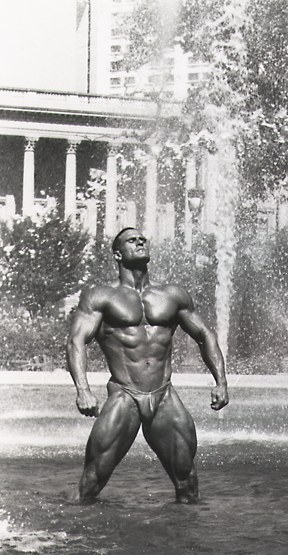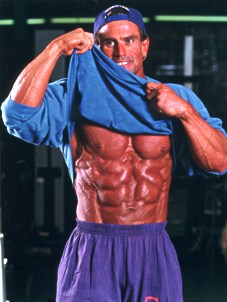

ECCENTRIC
CONTRACTION
PRIME MOVER MUSCLES
Muscles that are principally responsible for a given joint movement are called prime mover muscles. For example, the biceps muscles are prime movers for elbow flexion exercises such as the biceps curl. The biceps muscles contract concentrically during the lifting phase and eccentrically during the lowering phase of this exercise.
ANTAGONIST MUSCLES
Muscles that
produce the opposite joint movement are referred to as antagonist muscles.
For example, the triceps muscles responsible for elbow extension serve
as antagonists to the biceps muscles. Antagonist muscles work cooperatively
with prime mover muscles to produce smooth and controlled joint movements.
STABILIZER MUSCLES
Muscles that stabilize one joint so that the desired movement can occur at another joint are known as stabilizer muscles. For example, during the biceps curl exercise, the pectoris major and latissimus dorsi muscles contract isometrically to stabilize the shoulder joint so that controlled movement can occur at the elbow joint.
STRENGTH FACTORSThere are a number of factors that affect our strength performance over which we have little control. These include gender, age, limb length, muscle length, tendon insertion, muscle fiber type, and motor learning.
GENDER
Gender does not affect the quality of our muscle, but it does influence the quantity of our muscle. Although male and female muscle tissue is essentially the same, men typically have more muscle than women because muscle size is positively influenced by the presence of testosterone, a male sex hormone. Because most human muscles produce approximately 1-2 kilograms of force per square centimeter cross-sectional area, larger muscles are stronger muscles. However, when evaluated on a pound-for-pound basis, men and women demonstrate similar strength performance. For example, one study evaluated quadriceps strength in more than 900 men and women. The average male performed 10 strict leg extensions with 62 percent of his body weight, and the average female completed 10 strict leg extensions with 55 percent of her body weight. If lean body weight were substituted for total body weight the average performance scores would have been even closer.
AGE
Recent research has revealed that men and women of all ages can increase their muscle size and muscle strength as a result of progressive strength training. However, the rate of strength gain appears to be greater during the
years of normal growth and development, which may generally be considered
from ages 10 to 20. After reaching maturity, muscular improvements usually
come more slowly, necessitating a more patient approach toward strength
training.
LIMB LENGTH
There are several reasons for avoiding strength comparisons with other individuals. One of these is related to limb length. Other things being equal, persons with short limbs may use more exercise resistance than persons with long limbs because favorable leverage factors enhance effective force output. For example, Jim and John have identical strength capacity in their biceps muscles. However, because Jim has a shorter forearm he can hold more weight at 90 degrees of elbow flexion because of the leverage advantage.
MUSCLE
LENGTH
Muscles are
attached to bones by connective tissue called tendons. Relative to bone
length, some people have long muscles with short
tendon attachments, and some people have short muscles with long tendon
attachments. Other things being equal, muscle length will affect
strength development. Persons with relatively long muscles have greater
potential for
strength than persons with relatively short muscles.
Developing Size and Strength
TENDON INSERTION
Another factor
that influences effective muscle strength is the point of tendon insertion.
For example, Susan and Gayle both have the same forearm length, biceps
length, and biceps strength. However, Susan's biceps tendon attaches to
her forearm a little farther from her elbow joint than Gayle's. This gives
Susan a biomechanical advantage that enables her to use more resistance
than Gayle in elbow flexion exercises. Humans have two basic types of
skeletal muscle fibers, generally referred to as slow twitch and fast
twitch. Slow-twitch muscle fibers are best suited for aerobic energy
use. They have the ability to produce lower levels of force for longer
periods of time. Conversely, fast-twitch muscle fibers are best
suited for anaerobic energy utilization. They have the ability to produce
higher levels of force for shorter periods of time.
Most men and women have a fairly even mix of slow-twitch and fast-twitch muscle fibers. However, some persons inherit a high percentage of slow-twitch muscle fibers that enhances their performance potential for endurance exercise. For example, world-class distance runners are born with a preponderance of slow-twitch muscle fibers that enables them to be successful in their events given appropriate training programs. Other persons inherit a high percentage of fast-twitch muscle fibers that enhances their performance potential for power activities. For example, world-class sprinters are born with a preponderance of fast-twitch muscle fibers that enables them to be successful in their events given appropriate training programs.
Although both fibertypes respond positively to progressive resistance training, the fast-twitch fibers experience greater increases in size and strength (hypertrophy). Consequently, persons with a preponderance of fast-twitch muscle fibers may obtain better results from their strength-training program.MOTOR LEARNING
It should be noted that much of the apparent strength gain observed during the early stages of training is due to neurological factors. That is, the muscle-fiber recruitment pattern becomes significantly more efficient during the first several exercise sessions. This is referred to as the motor-learning factor, and is responsible for much of the initial strength improvement experienced by new exercisers. Your ability to contract the muscle you have increases very quickly. Over your bodybuilding career your ability to contract,especially repetitiously, will increase dramatically. Now growing new bigger muscles is the trick. However, size not withstanding, your tendons will thicken over years of training and your contraction levels can get quite high.
BODYBUILDING SECRET - Great Strength will be built over years of lifting weights, and muscle size is not the absolute indicator of strength. A person with thick tendons and high contraction levels can be perceived as "thin" but be very strong.
![]()

